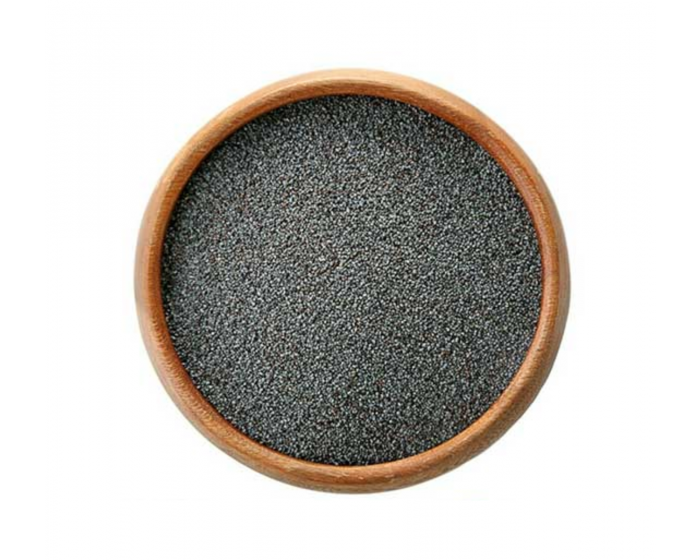Blue Poppy Seeds Bulk Wholesale
Botanical Name: Papaver Somniferum
Native to Southeastern Europe and Western Asia, breadseed poppy, Papaver somniferum was cultivated in Europe since the Neolithic era and in America as ornamental plants before 1750. This plant contains narcotic alkaloids which are the active compounds of opium and many refined opiates, such as morphine and codeine. Somniferum – meaning “sleep bringing” in Latin – refers to the narcotic properties of the plant. Most of the medicinal opium in the world is produced in India and Turkey. Opium is extracted primarily from the seed capsules. The edible seeds are widely used in baked goods such as bagels, muffins and cakes, and since they contain 40- 50% oil can be pressed for oil for cooking – similar to sesame oil – or for use in oil-based paints.
Breadseed poppy plants grow quickly from seed up to three feet tall. They are hardy, cool season annuals, germinating early in the season and the foliage is not affected by light frosts (the flowers are sensitive to freezing). The dull green to blue-green, glaucous leaves clasp the strong upright stems growing from a stout tap root. The smooth leaves have jagged edges and a crisp texture, resembling loose-leaf lettuce leaves. The foliage begins to decline once the plant is in bloom, and by the time the flowers are done will dry up completely.
Blooming in early- to mid-summer, this common annual can have flowers in many shades of pink, red and purple, as well as white and bicolors. Single types have 5 luminous, papery petals, while double types have many more. Singles or partly double forms form a cup shape, with a dark or white blotch at the base. Flowers on large plants can be up to 4 inches across. The paeoniflorum group has double flowers that are reminiscent of a peony and the laciniatum group has highly double flowers with deeply lobed petals that give the flower a ruffled, pompon appearance.
Fat, dull-green, buds covered with soft hairs start out hanging from downward-nodding stems, like a shepherd’s crook, but become erect as the sepals open to reveal the tightly packed petals. The sepals typically fall off the plant, but occasionally will remain attached at the base of the flower. The plants are self-fertile, and are pollinated by bees. The flowers can be used as cut flowers, lasting longer if the cut stem is cauterized before placing in water.
In a few days the petals fall off, leaving behind an ovoid seed capsule. The green capsules swell to become up to as large as a golf ball. They turn brown as they mature. Each seed capsule contains numerous small, round black, white, or grayish-blue seeds with a favose-reticulate (honeycombed) seed coat. Large capsules can contain up to a thousand seeds. When ripe, several vents develop at the top of the capsule to allow the seeds to be dispersed. Dried mature seed capsules can be used in floral arrangements and crafts.
Use breadseed poppy in annual or mixed beds for its attractive foliage early in the season and the colorful flowers in the summer. They are bests mixed in with other plants which will disguise the senescing foliage as they finish blooming or will fill in after the plants are removed. They can also be grown in larger containers that provide enough room for good development.
Breadseed poppy is very easy to grow in full sun in well-drained soil. Plant rarely need staking, especially if spaced properly to allow for robust development. They have few pests other than aphids on occasion
.As annuals, poppies are only grown from seed, and self-sow readily. They do best sown directly in the desired location in either early spring or late summer/fall to germinate the following spring. Sprinkle the small gray, black or brown seeds on prepared soil, but do not cover. Mixing the seeds with some sand makes it easier to spread them more evenly over the planting area as you can see where you’ve broadcast them. Seeds should germinate in about a week or two in early spring. They germinate better in cool soil, so seeding later in the spring often is unsuccessful. They can also be started indoors if necessary, but need to be kept cooler than room temperature to do well. Once the seedlings are about an inch tall, thin the plants to about a foot apart. Remove the smallest plants (pull or cut off the tops), or transplant carefully, trying to disturb the roots as little as possible as they have very sensitive root systems and do not transplant well. Plants growing closer together will be small, weak, and produce fewer and much smaller flowers.
To reduce volunteers, deadhead before the seed capsules turn brown (or pull out the entire plant after flowering, but often larger plants are still producing flower buds when the first seed capsules are ripening). To save seed, invert opened capsules into a container. To sow in another area, just cut off the opened capsules and shake them over the new area.
Poppies hybridize easily, so if trying to save specific varieties, plant them far apart or cover the flowers with small bags as they open to prevent cross pollination (but you may need to hand pollinate by moving the pollen from the anthers to the stigma with a small brush).

